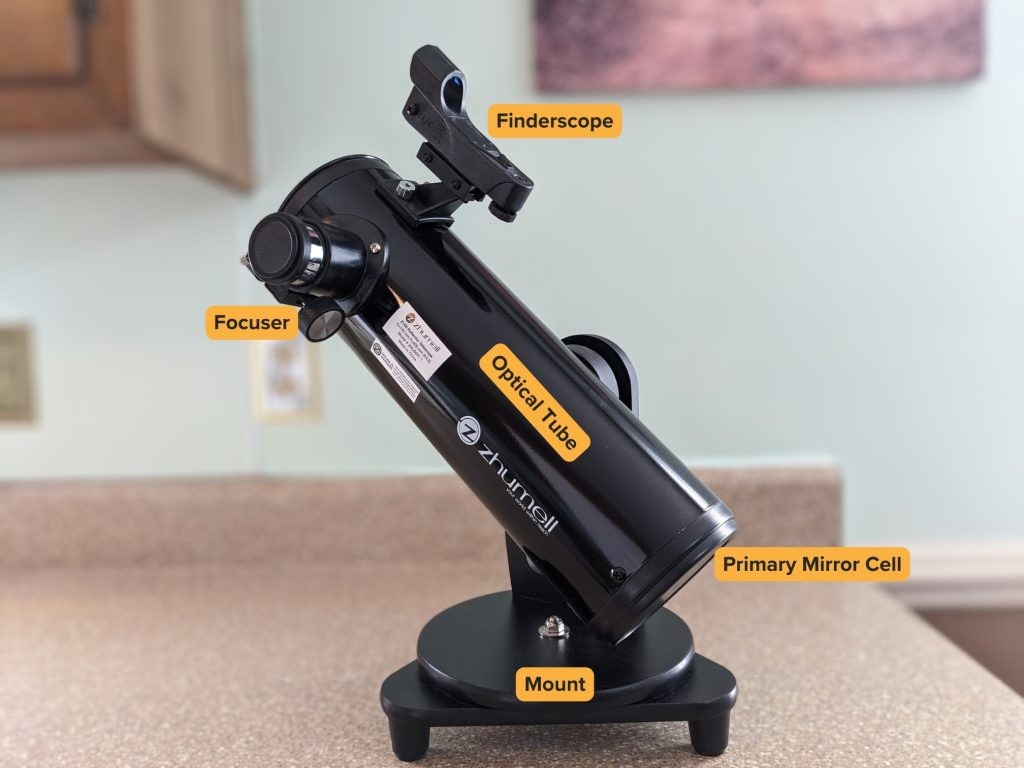
The Z100’s Newtonian Reflector Optics
The Z100 is a 100mm (3.93”) Newtonian reflector with a focal ratio of f/4. At such a fast focal ratio, you’d expect there to be some coma. But it’s not noticeable with the stock 17mm and 10mm eyepieces. With a lower-magnification eyepiece like a 25mm Plossl, I start to spot it at the edges of the field of view.
The Z100’s focuser is a 1.25” rack-and-pinion consisting partially of plastic. I find it works adequately.
The Tricky Collimation Aspect
At a focal ratio such as f/4, precise collimation is critical for optimal performance with any reflector. Unfortunately, the folks at Zhumell have declined to offer this crucial feature, and the primary mirror sits in a static, non-collimatable cell.
The scope keeps its collimation pretty well over time, which is good. But the lack of adjustments is, to say the least, a bit of a worry. Also, I know firsthand that Zhumell won’t be able to help you much if your scope is out of collimation and needs to be replaced or fixed.
The Z100’s secondary mirror is collimatable, but you shouldn’t ever need to touch it.
The Accessories
The Z100 comes with two eyepieces: a 17mm Kellner (24x) and a 10mm Kellner (40x).
Even though the eyepieces don’t have rubber eyecups, which I find annoying, these eyepieces are good. They are made entirely of metal and glass, with no plastic, unlike the eyepieces that come with many similarly priced telescopes that I’ve personally tested. The 10mm, however, has a short eye relief, and its short length may cause your nose to bump into the telescope when you look through it.
The Z100’s wide field of view at low power (over 2 degrees with the stock 17mm and up to 4 degrees with optional lower power/wider field oculars) makes it extremely easy to find deep-sky objects with little in the way of practice.
Theoretically, the scope could handle up to 150–200x magnification, but I find that the mount is a little annoying to use above 100x or so, and the optics max out at around 150x from my experience.
The most crucial additional accessory I would recommend for this scope would be a 6mm “gold-line” eyepiece or a 2x Barlow lens.
The 6mm Goldline gives you 66x magnification, which lets you see planets better than the stock 10mm Kellner, which only gives you 40x.
Alternatively, the 2x Barlow coupled with the stock 10mm eyepiece provides 80x.
If you can only pick one, I would recommend the 6mm Goldline. But if you’re able to buy both, you could also buy Barlow with the 6mm eyepiece for an astounding 133x, which is about the practical limit of what this telescope can provide.
The Z100 also includes a standard red dot sight, which works just fine for this telescope.
The Z100’s Tabletop Dobsonian Mount
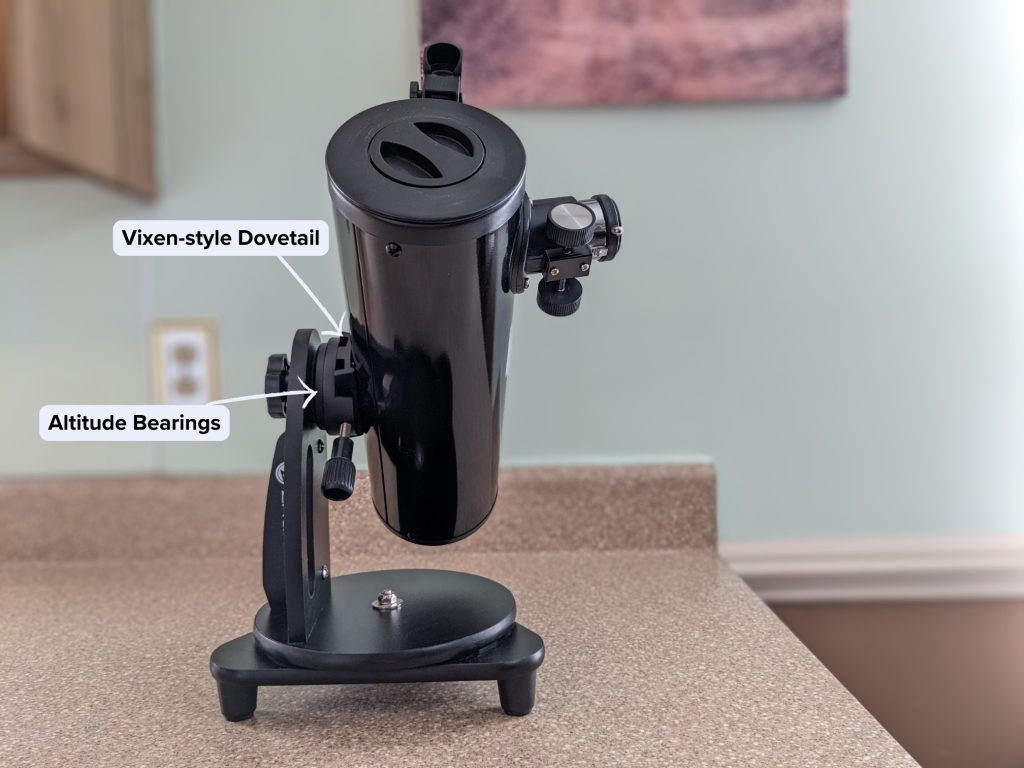
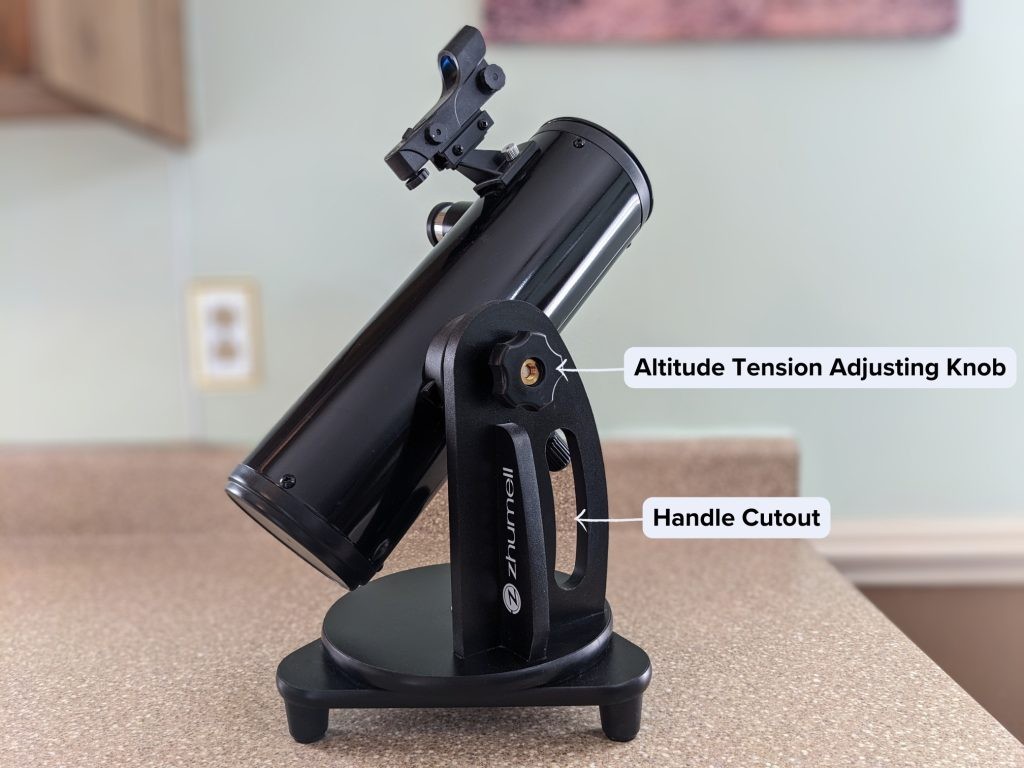
The Z100 comes on a fairly utilitarian tabletop Dobsonian mount, which it attaches to via a plastic Vixen dovetail saddle. The altitude bearing is not of the conventional Dobsonian design but works nonetheless. Additionally, the mount has a small cutout for use as a handle.
I’ve found that the mount is made mostly of particleboard with some sort of laminate glued on, but the azimuth bearings are in fact real Teflon pads.
If you don’t have a sturdy enough table or bar stool to set the Z100 on, the bottom of the mount has a ¼ 20 threaded hole, so you can attach it to most photo tripods. You can also set the scope on the hood of your car, which is arguably a more stable option than a lot of cheap tripods or folding tables.
Alternative Recommendations
If you’re willing to spend more, here are a few of our picks at higher price brackets:
- The Sky-Watcher Heritage 150P and the smaller 130P both deliver significantly more aperture, and thus better performance, than the Z100 or larger 114mm tabletop reflectors, but in a similarly compact, convenient, and portable package.
Aftermarket Accessory Recommendations
The f/4 focal ratio of the Z100 prevents the use of a 25mm or 32mm Plossl for wider fields of view. A 6mm “gold-line” will provide 67x. For even more magnification, you could add a 2x Barlow lens to get 80x with the included 10mm and 133x with the 6mm goldline, which are pretty decent magnifications for lunar or planetary viewing with a telescope of the Z100’s size and capabilities. But besides an extra eyepiece and/or Barlow, we wouldn’t suggest buying more accessories for the Z100 instead of just getting a bigger telescope.
What can you see with the Zhumell Z100?
The Z100 will offer great views of the Moon and decent views of Venus, Mars, Jupiter, and Saturn. Venus will show its phases, Mars its ice caps and maybe a few dark areas at opposition, and Jupiter and Saturn will show their moons and cloud belts. Jupiter’s Great Red Spot is also visible, as are Saturn’s majestic rings and the gap between them known as the Cassini Division. Uranus and Neptune are also visible as tiny bluish dots, but they are a bit tricky to locate.
A small, inexpensive refractor may do a slightly better job on the planets than the Z100, but the Z100’s larger aperture makes it superior for viewing deep-sky objects, and it’s also far more lightweight, compact, and portable than a refractor.
Outside the solar system, the Z100 can show you thousands of double stars and hundreds of open star clusters. You’ll be able to spot globular clusters as fuzzy smudges, a few dozen of the brightest galaxies, and, with luck, maybe pick out hints of detail in a few, such as the dust lanes in M82 or M31. However, doing this will require dark skies. The Zhumell Z100 is also capable of showing various bright nebulae like Orion, the Lagoon, the Dumbbell, and the Ring, which will look great even in light-polluted skies.

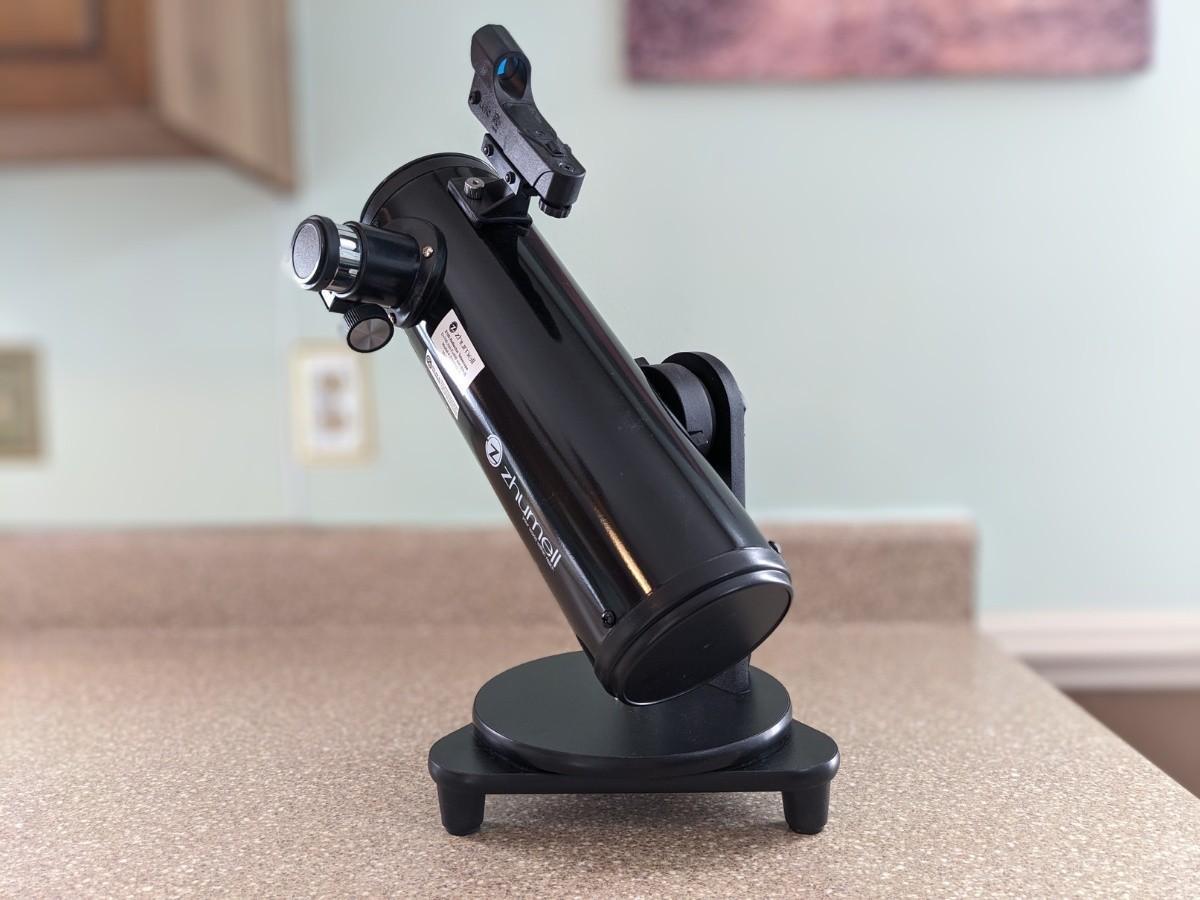
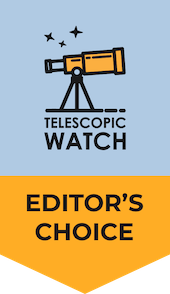

I also bought the 114az sr and after reading your comments and amgoing to purchase the exploascope 80az80mm refractor to compare. Is this the one you referred to in your comment that would be better? We really want to see planet details and is the refractor good for that vs the reflector because I’ve read both are better for viewing different things ? Thanks in advance
Sometime between yesterday and today the price of this telescope jumped up from 99.99 USD to between 150 USD and 250 USD, making it no longer fit into the $100 category, and making it a hard sell compared to the nearly identical Orion model.
So, I got one base on this recommendation and paired it with an Orion 52587 VersaGo E-Series Altazimuth Mount Head with Tripod. I thought about purchasing the Orion SkyScanner 100mm TableTop Reflector Telescope but deemed the placement of the finderscope and the focuser as bizarre and ill-conceived. They engineered themselves into a hole focused on the upselling of their Orion StarBlast AutoTracker Altazimuth Mount Tripod to mount the little dob, rather than creating something with interoperability for Vixen side-mount tripods. With that said, I wanted something with slow-motion controls and to be able to walk around in a field and not lay on my stomach to use the finderscope. Collimation is spot-on, and the optics are crisp & precise, really stunning for such a diminutive scope, the only negative, a wobbly focuser! Poor material design-Arg!!! Not to fret, as this common to low-cost telescopes with plastic focusers and readily rectifiable with an application of some 100% virgin Teflon tape stripes. The eyepieces are a toss. There is no Barlow. The finder is identical to the Orion EZ Finder II Telescope Reflex Sight, which recently had a re-design. The scope works well with the Celestron 8-24 mm zoom as well as the 7 & 5 mm X-Cel LX eyepieces. Thumbs up, in this hobby, you could make a lot worse purchase.
I’ve had this lil baby for a year now.
It’s a perfect scope for a casual observer.
Update:
I’ve improved the focusser by attaching a larger “knob” on one side which allows much finer tuning that the standard setup. I now find myself using the scope attached to my tripod more than on its Dobsonian stand. I find it much more convenient to use that way.